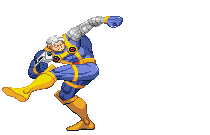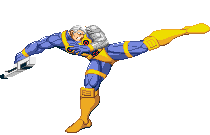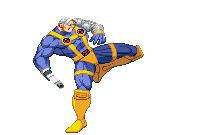In the first part of this three part post I started with a basic premise: every move you can think of has already been created. I focused on Marvel vs Capcom 2 as a powerful resource for studying cool and powerful moves, as it has both depth and breadth in play, and it has a large tapestry of themes to pull from. Now we are going to get into the nitty-gritty fun of breaking down moves by understanding not only what you are seeing, but also why you are stealing it.
Just to be clear: my vocabulary is NOT congruous with the MvC2 community. These are the terms I was taught while working on god of war, which I have adapted and applied to the game of MvC2. I do this, number one, because it is easier for me to think in terms of god of war terminology, and number two, I do it to reinforce the idea that this is not “about” MvC2. The purpose is to talk about how to effectively construct ideas for use in an action adventure game, with MvC2 being the greatest source.
All moves are broken down into three stages: Action, Reaction, and Result. The player performs some action, his opponent reacts, and it results in both of their status changing. Some moves involve all three stages (throwing a fireball), while others might only involve one (teleporting), and yes, sometimes it can be hard to fit moves into any mold. Do not lose heart but instead remember: eventually you are going to reconstruct these ideas into your own moves. A structured approach helps in both construction and balance; additionally, this way of thinking reminds you of the important questions to ask: what does it look like, what does it do, how do I react, why should I use it, and how can I counter it?
When designing, there are those rare moments where the process seems to flow naturally. Inspiration is striking left and right, and you know the exact move that you want. One look at a piece of concept art, and you know exactly what moves it should have. These perfect moments are all too uncommon. Inspiration, that most elusive friend, chooses when she wants to strike; however, that doesn’t mean we just sit around waiting. That’s where mining for ideas comes in, and whether we are looking for a move to fit a monster, or hoping to find a monster to fit a move, the search starts with an action.
Action
Every move your character makes is some kind of action. The first step in deconstructing the actions you see in MvC2, or any game, is by understanding their basic structure. A move is made up of frames of animation, and these frames are broken down into three stages: Startup, Hit, and Recovery.
- Startup: The move is starting, but nothing has happened yet. If I was going to punch you, this would be the part where I pull my hand back and get ready – my muscles tightening in preparation. The longer this period last, the more time your opponent has to figure out what move you are doing and react. When someone says a move is “telegraphed”, they are likely referring to the fact that a move had a long and obvious startup.

Frame 5: Readies the kick
- Hit: The move is now “active”. If it was a punch and it was touching someone else, this would be the part where they take damage and react to it. The longer this period lasts, the easier it is to hit someone. At first glance it appears that “longer is better”, however the longer your hit frames are active the more time your character spends locked into this move. In Street Fighter 2, M. Bison’s crouching heavy kick (c.HK) makes him slide along the floor a decent distance. His hit frames encompass the entire slide, which makes it a risky move. If the other player blocks the move, since you are still locked into the slide, they can easily counter attack.

Frame 8: Extends and connects
- Recovery: The move is no longer active, but I must spend time recovering back to my “rest” state before I can perform another move. If I was punching you this would be the time it takes me to bring my hand back. If I really put my all into this punch, it could also be the time I spend trying to catch my breath. The longer the recovery, like having a large number of hit frames, means that you are locked into this move, or “committed”. A particularly powerful move might be balanced by having a long recovery – high risk high reward.

Frame 12: Brings the leg back
Fighting games, action adventure games, beat em ups… they all make it or break it by the strength of their melee moves. Do they feel powerful, do they flow, and do they make sense. The majority of moves in MvC2 – in fighting games in general – fall into the category of melee moves. From quick jabs that let you poke your opponent to death, to arm-stretching overhead smashes that flatten them to the ground; the number of ways you can slap some part of your body against someone else is as varied as our imaginations. This variety comes from the interplay between three attributes: Power, Range, and Speed. These attributes are a sliding scale and not a harsh choice – imagine dials not check boxes.
Understanding how to adjust these dials requires a firm grasp of our three stages of a move. You can have the most powerful move in the game and I the weakest, but if my move has fewer start up frames I will beat you all day every day. My speed defeats your power, and while we could fix this by giving that powerful move greater range, the better solutions present themselves when we have a robust understanding of reactions, and how different kinds of reactions (or a lack of them) can be used to balance moves.
Reaction
Actions are the fun part – the part we fixate on – but they are not the most important part. A powerful move feels like a powerful move only when it is sold by a powerful looking reaction. Understanding how and why characters react to various moves is integral in making sure your moves don’t come off feeling underwhelming, or even worse, comical.
As you study moves, observe the difference between an opponents normal reaction and his reaction when blocking (guarding). When you are hit by a move, much like when you perform an action, you play an animation, and your character is locked into this reaction for a period of time. The reaction animation you play is, most times, visually different when you are guarding, but more importantly, the animation you are forced to play is shorter (fewer frames). The variance in length between taking a hit and guarding a hit can mean the difference between landing a combo, or getting brutally punished. A normal reaction means that you are stuck in Hit Recovery (also called Hit Stun). If you are guarding, you are stuck in Guard Recovery (also called Block Stun). Note: I do not like the terms stun or block. The former because you are not actually stunned, and the latter because blocking implies a negation of all damage, while guarding implies a reduction in damage, which is more accurate.
Let’s say I have a punch with 2 hit frames, 4 frames of Recovery, and a kick with 3 frames of Startup. The punch causes 10 frames of Hit Recovery but only 5 frames of Guard Recovery. If I attack someone with this punch (and they do not guard it), I can combo into my kick and get a free hit (my hit, recovery and startup is less than his hit recovery). If they guard my punch, however, he will recover before I do. This is just a simple example, but you can see the importance in understanding the difference.

The attacker recovers first

The defender recovers first
This is just the beginning of what you can do when you begin to understand reactions. Return to the example above, with the ridiculously powerful but slow move and the weak but very quick move. The quick move was going to have the advantage, but what if we can introduce a new trick to the slow move? Some moves allow the player to have armor or “tank” through attacks. While tanking you take damage, but do not react. This gives you a clear advantage. The quick move will hit you, and you will take damage, but it’s no matter because you plow right on through and smash that punk to bits – huzzah! Tanking is an example of a modifier that we can place on a move, and it’s not the only one you can use. Note: even though modifiers are an attribute of the action, I feel it’s important to talk about them here in reactions, because they deal almost exclusively with how you react (or don’t react) to moves. There are quite a few modifiers, and again, these are terms I learned from working on god of war, but you can see most of them in some form in MvC2:
- Tank: You take damage, but do not play reactions. Sometimes a move can only tank a fixed number of hits. For example, you can tank the first hit, but if you are hit a second time you play a reaction normally.
- Invulnerable: You take no damage and do not play reactions.
- Guard Break: Attempting to block a move with this attribute forces you to play a special kind of reaction. You do not take damage, but you are left vulnerable.
- Unblockable: Attempting to block a move with this modifier forces you to play a normal reaction as if you did not block it at all.
- Crumple: A special kind of reaction. Your character loses control for a period of time. Being hit while crumpled causes you to play a normal reaction. Note: THIS IS NOT THE SAME AS BEING STUNNED. When you are stunned and receive a hit, you remain stunned until a period of time has passed. The Crumple state, however, ends once you are hit.
- Frozen: Turned to ice, turned to stone; theme is irrelevant, the reaction is the same. You are locked down, stunned, and you cannot break free until a timer runs down. Note: this is the first time I have used the word stunned. That is because this is the first time it has been factually correct. Do not use it when not appropriate. It’s confusing, and only serves to weaken communication and meaning.
With all of the various reactions (normal hits, guarded hits, air hits, crumples, etc.) and with the knowledge that to truly sell an attack it has to have an appropriate reaction, you can see how the workload begins to balloon when left unchecked.
Note: If you don’t have time to make heavy reactions, all that time and effort making ‘cool’ heavy looking attacks is now worthless.
It is purely anecdotal, but it is my belief that what separates the good from the great is having a truly competent grasp of how important reactions are to the system; not just how to make them look good, but how to make them look good within a budget. Your workload dictates the possible reactions, the reactions dictate the feel of your attacks, and the feel dictates the final piece, your results.
Result
What is the difference between reaction and result? Viewed casually, reactions seem to be results, but there is a worthwhile distinction here. First, a move can have a result without a reaction (I drink a health potion). Second, and more important, reactions are animations, while results are changes in state.
State, in this context, refers to more than just the health of your character. Other changes in state range from altering your current armor rating, to altering whether you are considered on the ground or in the air. For clarity I will break them down into categories, and then provide some examples within each category to illustrate its uses.
Health
- Damage: A fixed reduction in health. The amount of damage done is scaled by two factors: the opponents armor class, and the current combo count. A character like Sentinel takes less damage from hits than someone like Akuma because they have different armor class ratings, additionally, the more you hit someone, the more your damage is scaled down (eventually reducing down to 1 damage per hit).
- Poison: A fixed reduction in health over time.
- Heal: A fixed increase in health
- Regen: A fixed increase in health over time
- Drain: Reduces health from one person, healing someone else for some fraction of damage done.
Defense
- Armor: Increases or decreases the amount of damage scaled by your armor.
Time
- Increase: Making one character move faster than another is a simple to understand, if complex to implement, example of this concept, but a better illustration is to consider what happens if we simply reduce the number of startup frames a character plays.
- Decrease: Much the same, but in reverse. I could increase the length of my opponents recovery, giving me a major advantage.
Position
- Impulse: Not all moves shove you across the screen, some suck you in. Impulse is the generic attribute, applied programmatically, of how much (both positive or negative) something shoves you.
- Launch: Knocking an enemy into the air places him into a completely new state. The game must understand not only that he acts differently, but also that he reacts differently. There are a whole new set of reactions to play when you are in the air; remember what I said about your workload ballooning when you don’t pay attention?
Results are easy to grasp and fun to think about, but do not get carried away. Their simplicity in concept belies their complexity of implementation. For every system you wish to modulate, the programmers must expend time and effort making that system variable instead of fixed. Pick your battles carefully.
A Job Half Done
Action, Reaction, and Result. These stages help us answer three questions: what does it look like, how do I react to it, and what does it do? We have yet to learn why we should use it and how to counter it, but these questions are answered by taking the deconstructed parts and ideas and reconstructing them into a coherent package. It sounds a hell of a lot easier than it is, and crafting new ideas from our deconstructed parts can, once started, seem like a Herculean task; however, with some simple guidelines (and patience), it is very manageable – maybe even fun.